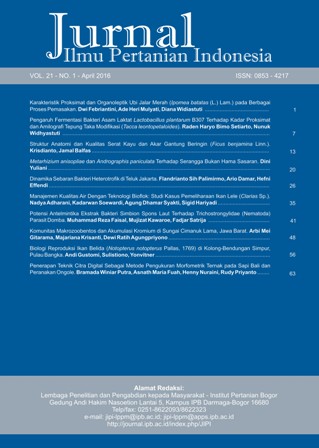Karakteristik Proksimat dan Organoleptik Ubi Jalar Merah (Ipomea batatas (L.) Lam.) Pada Berbagai Proses Pemasakan
Abstract
Sweet potato (Ipomea batatas (L.) Lam.) is one of functional foods that can maintain and improve human health. Due to the very hard texture of red sweet potato, it cannot be consumed directly. Therefore, it requires various cooking methods in order to be more suitable for consumption. This study aimed at determining effects of various cooking methods on the proximate and sensory properties of red sweet potato. The research covers various cooking methods of red sweet potato through boiling, frying, baking, steaming, and one treatment without cooking process (fresh) which was used as a control. The results show that various cooking methods affect almost all testing parameters significantly, except for ash content. Baked red sweet potato has the lowest moisture content (38,75%) and the highest sugar value as sucrose (17,17%). Sensory properties test results show that the most preferred red sweet potato is fried red sweet potato.
Downloads
References
Abdel-Kader ZM. 1991. Effect of boiling and baking on the content of some nutrients of sweet potatoes. Die Nahrung. 35(3): 321-324. http://doi.org/c98vt3
[AOAC] Association of Official Analytical Chemistry. 2005. Official Method of Analysis 18th Edition. Maryland (US): AOAC International.
Azizah AH, Wee KC, Azizah O, Azizah M. 2009. Effect of boiling and stir frying on total phenolics, carotenoids and radical scavenging activity of
pumpkin (Cucurbita moschato). International Food Research Journal. 16(1): 45-51.
Belitz HD, Grosch W, Schieberle P. 2009. Food Chemistry 4th revised and extended ed. Berlin (DE): Springer.
Blessington T, Nzaramb MN, Scheuring DC, Hale AL, Reddivari L, Miller JrC. 2010. Cooking methods and storage treatments of Potato: Effects on
Carotenoids, Antioxidant Activity, and Phenolics. American Journal Potato Research. 87(6): 479-491. http://doi.org/b6b4wf
Bolívar ACC, Luis CZ. 2004. Stability of anthocyaninbased aqueous extracts of Andean purple corn and red-fleshed sweetpotato compared to
synthetic and natural colorants. Food Chemistry. 86(1): 69-77. http://doi.org/fmgff5
BPOM-RI. 2005. Peraturan Kepala Badan Pengawas Obat dan Makanan Republik Indonesia tentang Ketentuan Pokok Pengawasan Pangan Fungsional. Badan Pengawas Obat dan Makanan Republik Indonesia. Jakarta (ID).
Cavalcanti RN, Santos DT, Meireles MAA. 2011. Nonthermal stabilization mechanisms of anthocyanins in model and food systems-an overview. Food Research International. 44(2): 499-509. http://doi.org/bqk7fm
Chumyam, Whangchai AK, Jungklang J, Faiyue B, Saengnil K. 2013. Effects of heat treatments on antioxidant capacity and total phenolic content of four cultivars of purple skin eggplants. ScienceAsia. 39(3): 246-251. http://doi.org/bdrm
Damir AA. 1989. Effect of heat penetration during cooking on some physico-chemical properties and microstructure of sweet potatoes. Food Chemistry. 34(1): 41-55. http://doi.org/fb3k3k
Dawson EH, Harris BL. 1951. Sensory methods for measuring differences in food quality: review of literature and proceedings of conference. Agriculture Information Bulletin No.34 United States Depatment of Agriculture, Washington DC (US).
dos Reis LCR, de Oliveira VR, Hagen MEK, Jablonski A, Flôres SH, Rios AO. 2015. Effect of cooking on the concentration of bioactive compounds
inbroccoli (Brassica oleracea var. Avenger) and cauliflower (Brassica oleracea var. Alphina F1) grown in an organic system. Food Chemistry. 172: 770-777. http://doi.org/bdrn
Islam SMD. 2006. Sweetpotato (Ipomoea batatas L.) Leaf: Its Potential Effect on Human Health and Nutrition. Journal of Food Science. 71(2): R13-R121. http://doi.org/bjn8vc
Jimenez-Monreal AM, Garcia-Diz L, Martinez-Tome M, Mariscal M, Murcia MA. 2009. Influence of cooking methods on antioxidant activity of vegetables. Journal of Food Science. 74(3): H97-H103. http://doi.org/d467m6
Kroh LW. 1994. Caramelisation in food and beverages. Food Chemistry. 51(4): 373-379. http://doi.org/fn9z9z
Martins SIFS, Jongen WMF, van Boekel MAJS. 2001. A review of Maillard reaction in food and implications to kinetic modelling. Trends in Food Science & Technology. 11(9-10): 364-373. http://doi.org/chsfwx
McGee H. 2004. On Food and Cooking (The Science and Lore of The Kitchen) Revised Edition. New York (US): Scribner.
Nielsen SS . 2003. Food Analysis. New York (US): Kluwer Academic/Plenum Publishers.
Oboh S, Ologhobo A, Tewe O. 1989. Some aspects of the biochemistry and nutritional value of the sweet potato (Ipomea batatas). Food Chemistry. 31(1): 9-18. http://doi.org/c4n3b3
Patras A, Brunton NP, O’Donnell C, Tiwari BK. 2010. Efect of thermal processing on anthocyanin stability in foods; mechaninism and kinetics of degradation. Trends in Food Science and Technology. 21(1): 3-11. http://doi.org/ctmbvc
Setyaningsih D, Apriyantono A, Sari MP. 2010. Analisis Sensori untuk Industri Pangan dan Agro. Ciampea (ID): IPB Pr.
Skipnes D, der Plancken IV, Loey AV, Hendrickx ME. 2008. Kinetics of heat denaturation of proteins from farmed Atlantic cod (Gadus morhua). Journal of Food Engineering. 85(1): 51-58. http://doi.org/b54s6g
[SNI] Standar Nasional Indonesia No.01-2892-1992. Cara uji gula. Badan Standardisasi Nasional, Jakarta (ID).
Tokusoglu O, Yildirim Z. 2012. Effects of cooking methods on the anthocyanin levels and antioxidant activity of a local turkish sweet potato [Ipomoea batatas (L.) Lam] cultivar hatay kirmizi: boiling, steaming and frying effects. Turkish Journal of Field Crops. 17(1): 87-90.
This journal is published under the terms of the Creative Commons Attribution-NonCommercial 4.0 International License. Authors who publish with this journal agree to the following terms: Authors retain copyright and grant the journal right of first publication with the work simultaneously licensed under a Creative Commons Attribution-NonCommercial 4.0 International License. Attribution — You must give appropriate credit, provide a link to the license, and indicate if changes were made. You may do so in any reasonable manner, but not in any way that suggests the licensor endorses you or your use. NonCommercial — You may not use the material for commercial purposes.






















